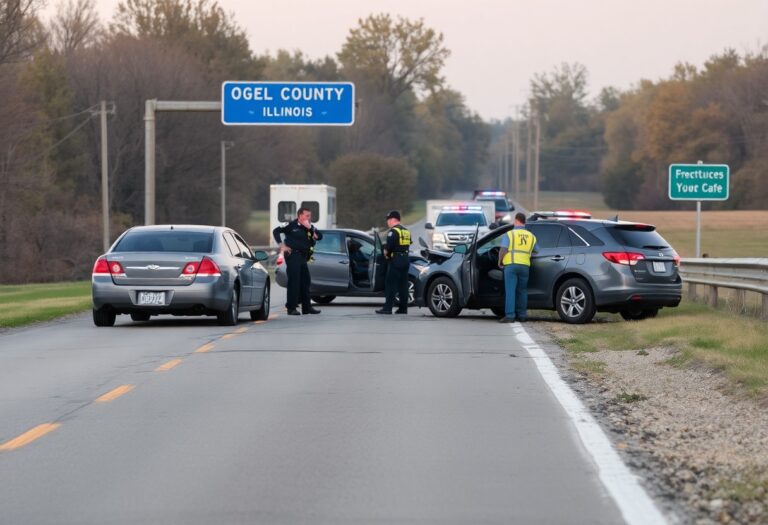There’s a straightforward process you can follow to obtain your car accident report in Johnson County, Wyoming. Understanding how to access this important document can make a significant difference in managing your insurance claims and legal matters. In this guide, you will learn step-by-step instructions on how to secure your report efficiently, ensuring you have all the necessary information at your fingertips. Follow these simple steps to streamline the process and get the assistance you need without unnecessary hassle.
Navigating the Legal Landscape of Car Accident Reporting
Understanding the legal aspects of car accident reporting in Wyoming is necessary for managing your situation effectively. This knowledge not only guides you through the reporting process but also helps safeguard your rights and interests. Knowing who is responsible for reporting, and how the information is used, can streamline your interactions with law enforcement and insurance companies.
An Overview of Legal Requirements in Wyoming
In Wyoming, law mandates that any car accident resulting in injury, death, or property damage exceeding $1,000 must be reported. You or another involved party must file an accident report with the local law enforcement agency within 10 days of the incident. Failure to comply may lead to penalties, making it crucial to adhere to these regulations.
The Role of Law Enforcement in Reporting
Law enforcement officers play a vital role in documenting car accidents. When they arrive at the scene, they assess the situation, provide assistance, and gather necessary details from involved parties and witnesses. A formal accident report generated by law enforcement serves not only for official records but also often becomes a critical piece of evidence during insurance claims or legal proceedings.
The accident report created by law enforcement includes crucial details such as the time and location of the accident, involved parties, vehicle descriptions, and witness accounts. This information is invaluable in clarifying the circumstances surrounding the incident and determining liability. In many cases, the report may also highlight any violations or infractions that occurred, further influencing the outcome of insurance claims or potential legal actions. Additionally, having an official record prepared by trained professionals lends credibility and reliability to your account of the event.
The Step-by-Step Process to Acquire Your Car Accident Report
Obtaining your car accident report in Johnson County, Wyoming, involves a straightforward process. Follow these steps to ensure you receive your report without unnecessary delays.
| Step | Action |
|---|---|
| 1 | Identify the right agency to contact. |
| 2 | Gather the necessary documents. |
| 3 | Submit your request in person or online. |
| 4 | Pay any applicable fees. |
| 5 | Receive and review your report. |
Identifying the Right Agency: Who to Contact?
To begin the process, contact the Johnson County Sheriff’s Office if law enforcement was involved in your accident. They maintain the official reports and can assist you in obtaining a copy. If your accident involved a city police department, reaching out to them directly might be necessary.
Documents You’ll Need for Your Request
Having the right documents ready makes your request smoother. Generally, you’ll need your driver’s license or ID, the date and location of the accident, and possibly the case number if available.
To streamline your request further, you can prepare a list of any vehicles involved, the names of involved parties, and detailed information regarding any witnesses. This extra detail not only helps in pinpointing your specific report but also speeds up the process as agencies can verify your identity and the details of the accident more efficiently. Always double-check the specific requirements for the agency you are contacting, as they may vary slightly, ensuring you’re fully prepared for your request.
Understanding Fees and Costs Involved
When obtaining your car accident report in Johnson County, understanding the associated fees is crucial. Costs can vary based on the method of request, whether it’s online, by mail, or in person. Additionally, the price may fluctuate depending on the number of copies you need and whether you require additional services, such as expedited processing. Keeping these factors in mind can help you budget for the request accordingly.
Potential Fees for Obtaining Your Report
Fees for obtaining your accident report typically range from $5 to $20, based on the format and delivery method you choose. For instance, an online request could incur a processing fee, while a physical copy obtained directly from the precinct might be slightly cheaper. Always check with the Johnson County Sheriff’s Office for the most accurate fee structure, as these costs can change.
Waivers and Reductions: When and How to Apply
You may qualify for a fee waiver or reduction if you face financial hardship or if you’re a victim of the accident. Addressing this situation generally involves submitting a waiver application explaining your current financial status and reasoning for the request. Local authorities may require documentation to support your claim, and it’s beneficial to clearly state your situation and provide any necessary paperwork to facilitate a prompt review of your application.
If you are considering applying for a waiver, gather relevant financial documents, such as pay stubs or tax returns, to substantiate your claim. The process may involve filling out specific forms available through the Johnson County Sheriff’s Office or their website. Highlight your status as a victim in the application, as reporting agencies often prioritize these requests for waivers to ensure you have access to necessary information without financial strain. Applying promptly following the accident can improve your chances of obtaining a waiver swiftly, allowing you to focus on recovery rather than costs.
The Waiting Game: Timeline for Report Acquisition
The time it takes to receive your car accident report can vary based on several factors, including the complexity of the incident and the method of request. Generally, you can expect to wait anywhere from 5 to 10 business days for a report to be processed and mailed or made available online. Keeping track of the timeline is necessary, as this information can be important for any legal or insurance claims you may need to file.
Expected Turnaround Times
Turnaround times for car accident reports typically vary, with most reports ready within 1 to 2 weeks after the accident. Depending on the reporting agency and circumstances surrounding the accident, this duration may fluctuate. If you’re in a hurry, reaching out directly to the agency that handled your accident might yield faster updates on your report status.
What to Do If There Are Delays
In case there are delays in obtaining your report, taking swift action can help you navigate the situation effectively. Begin by contacting the agency responsible for the report to inquire about the status. If you face recurring issues or very long delays, consider filing a formal request for expedited processing if applicable.
Delays might occur due to various reasons such as a backlog of requests or incomplete information from the involved parties. If you find yourself waiting longer than the typical timeframe, reaching out to the police department or records office directly can clarify any issues. Providing them with your accident report number or other relevant details may speed up the process. Additionally, consider keeping a log of your communications, as this can be useful if you need to escalate your request or address any disputes regarding the incident.
Tips for Accurately Reading and Interpreting Your Accident Report
- Carefully check the date and time of the accident
- Make sure your personal information is correct
- Examine details of the collision and witness statements
- Note any violations or contributing factors listed
- Compare descriptions of the damage to your vehicle
Knowing these aspects will enable you to understand your report better and address any inaccuracies promptly.
Key Sections of the Report Explained
The accident report is typically divided into several sections that provide necessary details about the incident. Start with the summary section which outlines the basic facts, such as the date, time, and locations of the accident. Next, examine the involved parties section, which lists information about drivers, passengers, and vehicles. The narrative section contains the officer’s viewpoint, detailing the sequence of events leading up to the accident. Finally, review any diagrams or photographs included, as these visual elements can clarify the accident’s context.
Common Misinterpretations and How to Avoid Them
Misreading your accident report can lead to unnecessary complications, especially when handling claims. Some individuals often confuse the roles of parties involved, believing that fault is automatically assigned based on the report. Pay close attention to the terminology used; words like “may” or “could” often indicate speculation rather than a definitive conclusion. This distinction is important in disputes about liability.
To avoid misinterpretations, focus on understanding the language and intent behind the report. The accident report might use vague terms or phrases that require further clarification. For example, if the report mentions “failure to yield,” consider that this could be subject to different interpretations based on the circumstances. Engaging with the officer who filed the report can provide clarity and ensure you aren’t basing conclusions on assumptions. Make sure to document any discrepancies, and don’t hesitate to seek assistance from a legal expert if needed.
To wrap up
Hence, obtaining your car accident report in Johnson County, Wyoming, is a straightforward process that you can navigate with ease. By following the outlined steps—gathering necessary information, contacting the appropriate law enforcement agency, and submitting any required forms—you’ll be well on your way to receiving your report. This information can be invaluable for insurance claims and legal purposes. Stay organized and proactive to ensure a smooth retrieval process, and keep a copy for your records when you receive it.













